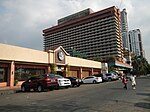Plaza Rajah Sulayman
Buildings and structures in Malate, ManilaLandmarks in the PhilippinesPlazas in Manila

Plaza Rajah Sulayman, also known as Rajah Sulayman Park, is a public square in Malate, Manila. It is bounded by Roxas Boulevard to the west, San Andres Street to the south, and Remedios Street to the north. The plaza is considered the center of Malate as it fronts the Malate Church, the main church of the district. The square is named after Rajah Sulayman, the late 16th-century sovereign of the Kingdom of Maynila. A statue of Rajah Sulayman sculpted by Eduardo Castrillo in 1976 is also located at the plaza.
Excerpt from the Wikipedia article Plaza Rajah Sulayman (License: CC BY-SA 3.0, Authors, Images).Plaza Rajah Sulayman
Roxas Boulevard Service Road, Manila Malate (Fifth District)
Geographical coordinates (GPS) Address Nearby Places Show on map
Geographical coordinates (GPS)
| Latitude | Longitude |
|---|---|
| N 14.568888888889 ° | E 120.98361111111 ° |
Address
Roxas Boulevard Service Road
1004 Manila, Malate (Fifth District)
Philippines
Open on Google Maps









